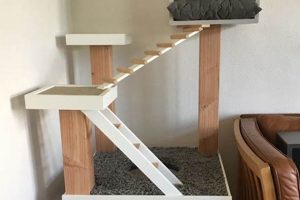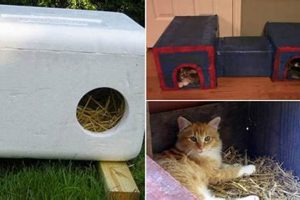A constructed refuge offering protection from the elements to free-roaming felines. These structures, often assembled using readily available or repurposed materials, provide insulation against cold, wet, or hot weather, creating a safe haven for cats living outdoors. An example is a simple box lined with straw, placed in a sheltered area of a yard.
Providing a safe and warm space for outdoor cats has a number of benefits. It increases the chances of survival during harsh weather conditions, mitigating the risk of hypothermia or heatstroke. These shelters also offer protection from predators and territorial conflicts, reducing stress and improving the overall well-being of the animals. Historically, such efforts reflect a growing awareness of animal welfare and a desire to mitigate the challenges faced by unowned or feral cat populations.
The following sections will delve into practical considerations for constructing such a haven, including design options, material selection, placement strategies, and maintenance guidelines to ensure its long-term effectiveness and continued use by the cats it serves.
Construction and Placement Considerations
These guidelines are provided to facilitate the creation of effective and safe outdoor havens for felines.
Tip 1: Insulation is Paramount: Employ materials with high insulation values, such as rigid foam or straw. Adequate insulation minimizes heat loss during cold weather and reduces heat gain during hot weather. For instance, a structure lined with several inches of straw provides significant thermal protection.
Tip 2: Waterproofing is Essential: Ensure the structure is waterproof to prevent moisture buildup, which can compromise insulation and create an unhealthy environment. Utilize waterproof materials for the roof and sides. A tarpaulin securely fastened over the shelter can provide an effective barrier against rain and snow.
Tip 3: Entrance Size Matters: Design the entrance to be small enough to retain heat and deter larger animals. An entrance size of approximately six to eight inches in diameter is generally sufficient. A flap over the doorway can further minimize heat loss and protect against wind.
Tip 4: Elevate the Structure: Raising the shelter slightly off the ground prevents moisture from seeping in and provides additional insulation. Placing the shelter on bricks or a wooden pallet is a simple and effective method.
Tip 5: Strategic Placement is Crucial: Position the shelter in a sheltered location, away from prevailing winds and heavy traffic. A location near a building or under dense shrubbery offers added protection. Avoid areas prone to flooding.
Tip 6: Multiple Exits are Recommended: Consider incorporating a back door to provide an escape route for cats in case of predators or territorial disputes. This promotes a sense of security for the inhabitants.
Tip 7: Monitor and Maintain: Regularly inspect the shelter for damage and ensure it remains clean and dry. Replace soiled or damp bedding as needed. Periodic cleaning helps prevent the buildup of parasites and bacteria.
Adhering to these recommendations enhances the functionality and durability of the constructed space, maximizing its benefits for feline occupants.
The final section addresses additional elements that will improve the safety and well-being of the sheltered animals, including feeding stations and veterinary care considerations.
1. Insulation Materials
The selection of insulation materials is paramount to the effectiveness of any outdoor feline shelter, directly impacting the thermal comfort and survivability of the inhabitants, particularly during periods of extreme weather. The appropriate choice of materials can significantly reduce heat loss in winter and prevent overheating in summer.
- Thermal Resistance (R-value)
The R-value quantifies a material’s resistance to heat flow; higher R-values indicate superior insulation. Materials such as rigid foam boards (e.g., polystyrene or polyisocyanurate) possess high R-values, providing excellent thermal protection. The practical implication is a more stable internal temperature within the refuge, regardless of external fluctuations. In contrast, materials with low R-values offer minimal protection and are unsuitable for extreme climates.
- Moisture Resistance
Insulation materials susceptible to moisture absorption lose their thermal efficiency and can foster mold growth, creating an unhealthy environment. Closed-cell materials, such as closed-cell spray foam or some types of rigid foam, are inherently more resistant to moisture penetration. Straw, while offering good insulation, can become damp and ineffective if not protected from moisture. Therefore, employing a vapor barrier in conjunction with moisture-sensitive insulation is crucial.
- Safety and Toxicity
The selected materials must be non-toxic and safe for feline contact. Some insulation materials may release harmful chemicals or fibers if disturbed. Natural materials like straw or recycled denim batting are generally safer alternatives to fiberglass, provided they are kept dry. Consideration of potential flammability is also essential; fire-retardant materials should be prioritized.
- Durability and Longevity
The durability of insulation materials influences the lifespan of the shelter. Materials that degrade quickly require frequent replacement, increasing maintenance costs. Rigid foam boards are more resistant to physical damage and degradation compared to loose-fill materials like straw. Proper installation and protection from the elements extend the functional life of any insulation material.
In conclusion, careful consideration of thermal resistance, moisture resistance, safety, and durability is critical when selecting insulation for outdoor feline shelters. The appropriate selection and application of these materials directly translate to improved feline welfare and reduced maintenance requirements, ensuring the refuge remains a safe and comfortable haven for its intended occupants.
2. Weatherproofing
Weatherproofing is a crucial component in the successful design and implementation of any outdoor feline shelter. The primary objective of a shelter is to provide protection from environmental elements, and compromised weatherproofing directly undermines this purpose. Inadequate protection from rain, snow, wind, or extreme temperatures negates the insulation properties of the structure, rendering it ineffective and potentially harmful to its occupants.
For instance, a cardboard box intended as a shelter, without a waterproof covering, rapidly degrades in wet conditions. This not only eliminates its insulating capabilities but also creates a damp environment conducive to bacterial and fungal growth, posing a health risk to the animal. Similarly, gaps in the shelters construction allow wind penetration, which significantly reduces the internal temperature, counteracting the intended thermal comfort. Effective weatherproofing necessitates the use of water-resistant materials for the shelters exterior, sealed seams, and an elevated base to prevent moisture absorption from the ground. The addition of an overhanging roof can further protect the entrance from direct rain or snow.
Ultimately, the effectiveness of an outdoor feline shelter hinges on its ability to maintain a dry and thermally stable environment. Comprehensive weatherproofing strategies are not merely desirable features, but fundamental requirements for ensuring the structure serves its intended purpose: to provide a safe and protective refuge for vulnerable animals. Neglecting weatherproofing compromises the shelter’s integrity and jeopardizes the well-being of its inhabitants, highlighting its integral role in shelter design and construction.
3. Entrance Size
Entrance size is a critical design element for outdoor feline shelters, impacting both the shelter’s functionality and the safety of its occupants. The dimensions of the entrance must strike a balance between accessibility for the intended feline inhabitants and the need to exclude larger animals or environmental elements.
- Heat Retention and Energy Efficiency
A smaller entrance reduces heat loss during colder months, thereby conserving the cat’s body heat and minimizing the energy required to maintain a comfortable internal temperature. Conversely, an excessively large opening allows for significant heat escape, rendering the shelter less effective as a thermal refuge. Empirical observations suggest an entrance size of approximately six to eight inches in diameter optimizes heat retention without impeding feline access.
- Predator Exclusion
The size of the entrance aperture directly influences the shelter’s ability to exclude potential predators, such as dogs, raccoons, or coyotes. A smaller opening makes it more difficult for these larger animals to enter, providing a degree of safety for the feline occupant. However, the entrance must remain sufficiently large to allow easy access for the cat, avoiding any sense of confinement or entrapment. The physical capabilities of the target feline population should be considered when determining optimal dimensions.
- Weather Protection
A reduced entrance size mitigates the ingress of wind, rain, and snow, all of which can compromise the shelter’s internal environment. A smaller opening reduces the area exposed to direct wind and precipitation, maintaining a drier and more stable interior. This can be further enhanced by incorporating an overhang or a flap over the entrance to deflect incoming weather elements. Shelters in regions with severe weather conditions particularly benefit from this design feature.
- Feline Comfort and Security
While functionality is paramount, the entrance size should not induce anxiety or discomfort in the feline. A too-small opening might create a sense of claustrophobia, deterring the cat from using the shelter. The entrance should be large enough to allow easy entry and exit, promoting a feeling of safety and security within the structure. Observational studies of feline behavior around shelters indicate that cats prefer entrances that offer a clear view of the surroundings while providing a sense of enclosure.
Ultimately, the optimal entrance size represents a compromise between competing demands: thermal efficiency, predator exclusion, weather protection, and feline comfort. Empirical evidence and observational data suggest that a carefully considered entrance size is crucial for maximizing the utility and effectiveness of an outdoor feline shelter, directly contributing to the welfare and survival of its inhabitants.
4. Elevated design
Elevating a feline shelter from ground level introduces multiple advantages critical to its functionality and longevity. Direct contact with the ground facilitates moisture wicking, leading to damp interiors, compromised insulation, and accelerated material degradation. Elevating the structure, even by a few inches, disrupts this process, promoting a drier and more hygienic environment for the animal. This is especially relevant in regions with high rainfall or snowfall, where prolonged ground contact can saturate the shelter, rendering it useless. Examples include shelters placed on bricks, wooden pallets, or cinder blocks, each providing a barrier against ground moisture.
Beyond moisture control, elevation also provides thermal benefits. The air temperature near ground level is often colder than at even a slight elevation, particularly during nighttime hours. Elevating the shelter creates a small buffer zone, mitigating temperature extremes and reducing heat loss. Furthermore, elevation can hinder access by certain insects and rodents, minimizing the risk of infestation within the shelter. Consider, for instance, a shelter designed for feral cats in a rural environment. Elevating it deters ground-dwelling predators and reduces the likelihood of attracting unwanted wildlife.
In summary, incorporating an elevated design into feline shelters significantly enhances their effectiveness and durability. By minimizing moisture intrusion, improving thermal regulation, and deterring pests, elevation contributes to a healthier and more comfortable environment for the animal. While seemingly a minor detail, this design element plays a crucial role in maximizing the benefits and lifespan of these shelters, particularly in challenging outdoor environments.
5. Strategic Placement
Strategic placement directly influences the efficacy of any outdoor feline shelter. A well-constructed shelter placed in an unsuitable location will likely remain unused, negating the resources invested in its creation. Conversely, a modestly built shelter in a strategically chosen location can significantly improve the survival chances of its inhabitants. The location must offer protection from the prevailing weather conditions, minimize disturbance, and provide a sense of security for the animal. The consequences of poor placement include reduced shelter utilization, increased exposure to predators, and diminished thermal protection.
Effective strategic placement involves several key considerations. Proximity to food and water sources is crucial, but these should not be placed directly adjacent to the shelter to avoid attracting unwanted animals. Positioning the shelter against a building or under dense shrubbery provides additional protection from wind and rain. Avoiding areas prone to flooding or with high foot traffic is also essential. For instance, a shelter placed near a busy street is unlikely to be used due to noise and perceived danger, while a shelter placed in a low-lying area is susceptible to flooding, rendering it uninhabitable during periods of heavy rain. Careful observation of the cat’s existing habits and preferred locations can inform optimal placement.
In conclusion, strategic placement is an indispensable component of a successful outdoor feline shelter program. It requires a thorough understanding of feline behavior, local environmental conditions, and potential threats. While the construction of a durable and well-insulated shelter is important, its ultimate effectiveness hinges on its strategic placement in a location that maximizes protection, minimizes disturbance, and provides a sense of security for its feline occupants. Addressing these considerations ensures the shelters provide a vital resource for vulnerable animals, improving their welfare and survival prospects.
6. Maintenance
Consistent maintenance is indispensable for preserving the functionality and longevity of outdoor feline shelters. Neglecting maintenance can lead to structural degradation, unsanitary conditions, and a compromised shelter environment, thereby negating the intended benefits of providing refuge to vulnerable animals. Scheduled inspections and timely repairs are therefore critical to ensuring the shelter remains a safe and habitable space.
- Regular Cleaning
Accumulation of debris, parasites, and waste products inside the shelter creates an unsanitary environment, increasing the risk of disease transmission. Regular cleaning, involving the removal of soiled bedding and the disinfection of interior surfaces, is essential. The frequency of cleaning depends on usage and environmental conditions, but a minimum of monthly cleaning is recommended. For example, straw bedding should be replaced if damp or soiled, and the interior should be wiped down with a pet-safe disinfectant.
- Structural Inspections and Repairs
Weather exposure and animal activity can cause structural damage, compromising the shelter’s integrity. Routine inspections should identify any cracks, leaks, or loose components. Timely repairs prevent minor issues from escalating into significant structural problems. For instance, a small crack in the roof should be sealed promptly to prevent water damage to the insulation, which can lead to mold growth and reduced thermal efficiency. Similarly, loose screws or nails should be tightened or replaced to maintain structural stability.
- Pest Control
Outdoor shelters can attract insects and rodents, posing a threat to the feline occupants. Implementing pest control measures, such as strategically placed traps or the application of pet-safe insecticides, helps minimize infestations. Inspecting the shelter regularly for signs of pests and taking appropriate action is crucial. For example, if fleas are detected, the bedding should be treated with a flea-control product specifically designed for cats, and the surrounding area should be monitored.
- Weatherproofing Renewal
The effectiveness of weatherproofing materials diminishes over time, requiring periodic renewal. Waterproof coatings, sealants, and weather stripping should be inspected and reapplied as needed to maintain the shelter’s resistance to rain, snow, and wind. For instance, a tarpaulin covering the roof should be checked for tears or punctures and replaced if necessary. Seams and joints should be resealed annually to prevent water intrusion.
These multifaceted maintenance practices, when consistently implemented, ensure that outdoor feline shelters provide a safe, hygienic, and functional refuge for their intended occupants. The proactive approach to maintenance not only extends the shelter’s lifespan but also significantly enhances the well-being of the animals it serves, thereby justifying the resources invested in its construction and upkeep. Regular application of these principles contributes to an effective and humane strategy for supporting feral and outdoor cat populations.
Frequently Asked Questions
The following questions address common inquiries regarding the construction, deployment, and maintenance of shelters for outdoor felines. The information provided aims to offer clarity and guidance for individuals seeking to provide safe and effective refuge for these animals.
Question 1: What are the essential materials for constructing an effective outdoor feline shelter?
Key materials include rigid insulation foam (for thermal protection), waterproof sheeting (for weather resistance), and durable construction lumber or recycled plastic (for structural integrity). Straw or other moisture-resistant bedding material is also essential for providing warmth and comfort.
Question 2: How crucial is insulation thickness for an outdoor feline shelter, and what are the recommended guidelines?
Insulation thickness is directly proportional to the shelter’s ability to retain heat during colder months. A minimum of two inches of rigid insulation foam is generally recommended, with thicker insulation (three to four inches) being preferable in regions with severe winter climates.
Question 3: What measures should be taken to ensure the shelter remains dry and free from moisture intrusion?
Employing waterproof materials for the roof and walls is essential. Sealing all seams and joints with waterproof caulk or tape prevents water penetration. Elevating the shelter off the ground on bricks or a pallet minimizes moisture wicking from the ground.
Question 4: What is the recommended size and placement of the entrance to balance accessibility and heat retention?
An entrance size of approximately six to eight inches in diameter is generally optimal. The entrance should be positioned away from prevailing winds to minimize heat loss and prevent rain or snow from entering the shelter.
Question 5: How frequently should an outdoor feline shelter be cleaned, and what cleaning agents are safe for feline contact?
Shelters should be cleaned at least monthly, with more frequent cleaning recommended during periods of heavy use or inclement weather. Use mild, unscented detergents or disinfectants specifically formulated for use around animals. Avoid harsh chemicals or bleach-based products.
Question 6: What steps should be taken to protect the shelter from predators and larger animals?
Choose a sheltered location away from areas frequented by predators. A small entrance deters larger animals from entering. Consider incorporating a second, smaller exit to provide an escape route for the cat. Securing the shelter to a stable object can prevent it from being overturned by larger animals.
The information presented highlights the importance of careful planning, material selection, and maintenance in ensuring the effectiveness of outdoor feline shelters. Adherence to these guidelines maximizes the shelter’s utility and promotes the well-being of its inhabitants.
The subsequent section explores advanced design considerations for specialized feline shelters, catering to specific needs and environmental challenges.
Conclusion
The preceding discussion has thoroughly examined the design, construction, placement, and maintenance of an outdoor diy cat shelter. Key considerations include the selection of appropriate insulation and weatherproofing materials, strategic placement to maximize protection from the elements and predators, and the necessity of regular maintenance to ensure a safe and hygienic environment for the animals it serves. Ignoring these factors can render the shelter ineffective, potentially endangering the very animals it intends to protect.
Therefore, creating such a structure necessitates a commitment to careful planning and diligent execution. The ethical responsibility to provide humane care for vulnerable feline populations demands that these shelters are not merely symbolic gestures, but rather functional and sustainable havens. Continued efforts to refine shelter designs and promote best practices in construction and maintenance are vital to improving the welfare and survival prospects of outdoor cats.







